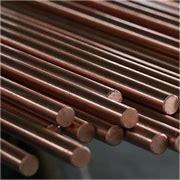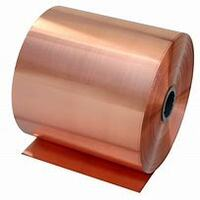1. Introduction
In the past 48 hours, global copper prices have surged due to supply chain constraints in Chile and increased demand from renewable energy infrastructure projects, directly impacting the copper rod price and related products like copper bonded ground rods and copper strip rolls. This volatility underscores the importance of understanding material differences when selecting conductive components for electrical, construction, or industrial use.

Copper remains indispensable across sectors—from power transmission to air conditioning systems—thanks to its unmatched conductivity, corrosion resistance, and ductility. However, not all ‘copper rods‘ serve the same purpose. Confusion often arises between solid copper rods, copper-bonded steel variants, and flat copper strips, each engineered for distinct functions. This article dissects these categories to clarify optimal usage scenarios, performance trade-offs, and economic considerations.
2. Solid Copper Rods: Composition and Applications
Solid copper rods—also referred to as copper round bar or round bar copper—are typically made from high-purity electrolytic tough pitch (ETP) copper (C11000). These rods exhibit excellent electrical and thermal conductivity, making them ideal for electrical busbars, motor windings, and high-current applications.
Key uses include:
- Manufacturing copper bus bar and flexible copper bus bar systems
- Fabrication of copper bars for sale in industrial markets
- Feedstock for drawing copper wire or producing copper ingot derivatives
Due to their purity, solid copper rods command a higher copper rod price compared to composite alternatives but offer superior longevity and performance in corrosive environments.
3. Copper-Bonded and Copper-Clad Ground Rods for Earthing
3.1. Material Structure and Terminology

The terms copper earth rod, earthing rod copper, ground rod copper, copper bonded earthing rod, and copper clad steel ground rod often describe similar—but not identical—products. Copper-bonded rods feature a steel core molecularly bonded with a thick layer of copper (typically 10 mils or more), whereas copper-clad variants use a thinner electroplated or metallurgically bonded copper layer over steel.
Both types leverage the tensile strength of steel and the corrosion resistance of copper, offering a cost-effective alternative to solid copper rods for grounding systems.
3.2. Performance and Cost Comparison
Copper bonded steel rods provide excellent durability in most soil conditions and are widely specified in telecom, utility, and building grounding. The earthing rod price for copper-bonded options is significantly lower than solid copper, yet they maintain effective conductivity over decades.
However, in highly acidic or saline soils, solid copper earth rods may outperform bonded variants due to complete corrosion immunity. For standard installations, copper clad earth rod or copper clad steel earth rod solutions remain the industry norm due to their balance of performance and affordability.
4. Copper Strips: Versatility in Flat Conductive Forms
4.1. Types and Specifications
Flat copper strips—marketed as copper strip, flat copper strip, copper metal strips, or copper strip roll—come in various alloys and tempers. Common variants include pure copper (C110), beryllium copper strip (for spring applications), and nickel plated copper strip (for enhanced solderability or corrosion resistance). Standard dimensions like 25x3mm or 1mm copper strip cater to specific electrical and mechanical needs.

Specialized forms such as copper roof strip, copper edging strip, and copper tape for snails (a horticultural deterrent) demonstrate the material’s adaptability beyond industrial use.
4.2. Applications in Grounding and Recycling
Copper strip for earthing is frequently used in substation grounding grids and lightning protection systems due to its ease of bending and high surface area. Meanwhile, the scrap recycling sector drives demand for stripping copper wire, with queries like ‘best way to strip copper wire’ and ‘fast way to strip copper wire’ trending among recyclers.
Important note: Burning copper wire for scrap is illegal in many jurisdictions and damages both the environment and copper quality. Mechanical stripping remains the recommended method for stripping wire for recycling or stripping copper wire for scrap.
5. Copper Rods in Joining Processes: Welding and Brazing
Copper welding rod and copper brazing rod serve fundamentally different purposes. Copper to copper welding rod (often phosphorus-deoxidized) is used in oxy-fuel welding of copper pipes, while copper to copper brazing rods (typically BCuP alloys) are preferred for capillary joint filling in HVAC and plumbing.
For air conditioning copper pipe repairs, technicians commonly use copper rod for welding or brazing to join 15mm copper pipe, 22mm copper tube, or 3/4 copper tubing sections. Proper copper pipe soldering requires clean surfaces and flux, whether resoldering copper pipe joints or installing new copper pipe and fittings.
Unlike PEX plumbing pipes, copper lines offer superior heat transfer and fire resistance, justifying their continued use in aircon copper tube systems despite higher ac copper pipe price points.
6. Market Considerations and Procurement Tips
When sourcing materials, buyers should distinguish between copper round bar (solid) and copper bonded variants to avoid specification errors. Similarly, searching for ‘copper strip near me’ or ‘copper bars for sale’ should account for alloy grade, temper, and dimensional tolerances.
Current trends show rising demand for flexible copper bar in EV charging infrastructure and data centers, while copper ingot price fluctuations directly affect downstream products like copper strip price and copper rod price.
7. Conclusion
Selecting the right copper-based conductor—whether a solid copper rod, copper-bonded ground rod, or flat copper strip—depends on application-specific requirements for conductivity, mechanical strength, corrosion resistance, and budget. Understanding the nuances between earthing rod copper, welding rod copper, and copper strip wire ensures optimal performance, regulatory compliance, and long-term cost efficiency in electrical and industrial projects.
Our Website founded on October 17, 2012, is a high-tech enterprise committed to the research and development, production, processing, sales and technical services of ceramic relative materials such as What. Our products includes but not limited to Boron Carbide Ceramic Products, Boron Nitride Ceramic Products, Silicon Carbide Ceramic Products, Silicon Nitride Ceramic Products, Zirconium Dioxide Ceramic Products, etc. If you are interested, please feel free to contact us.

